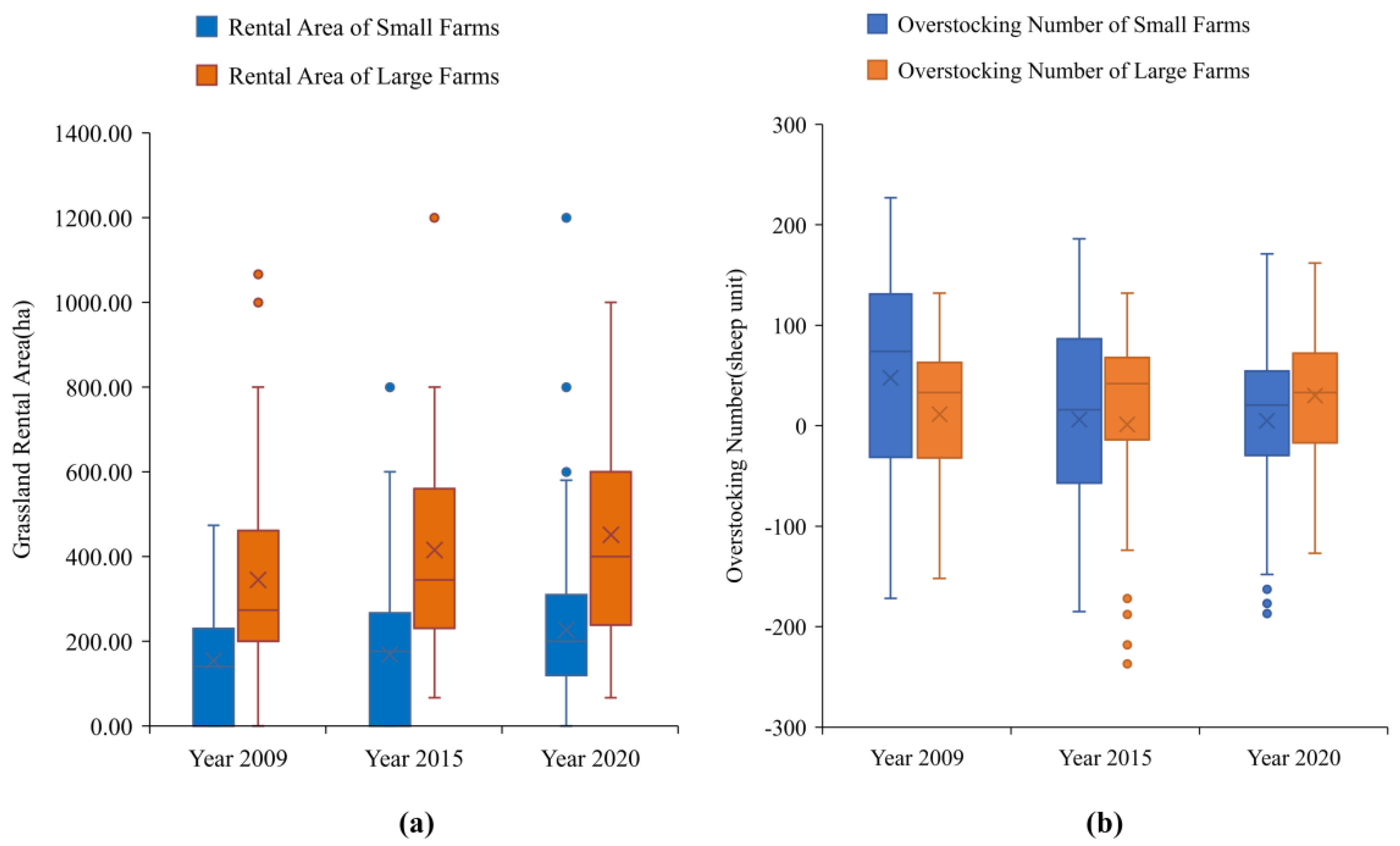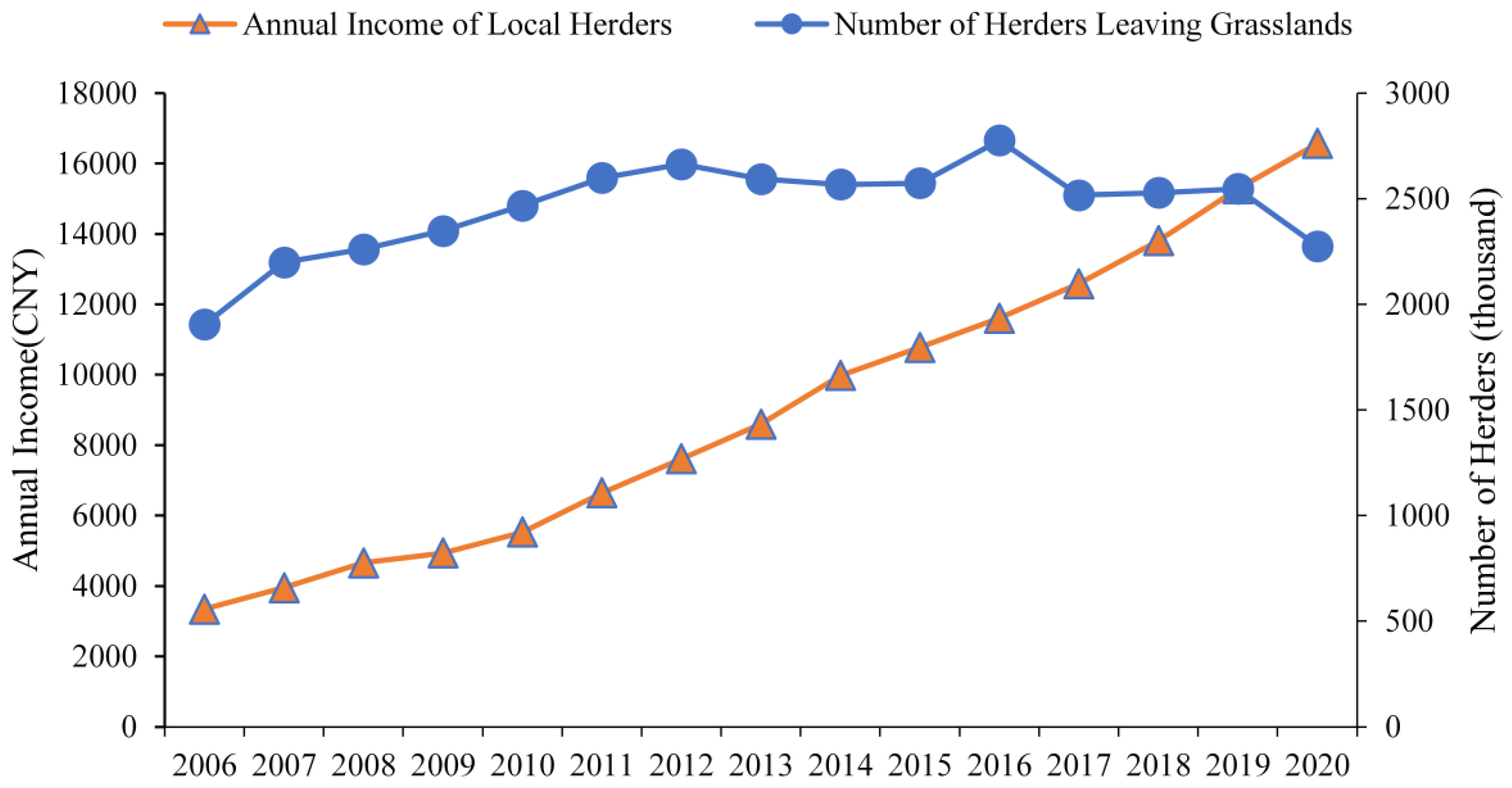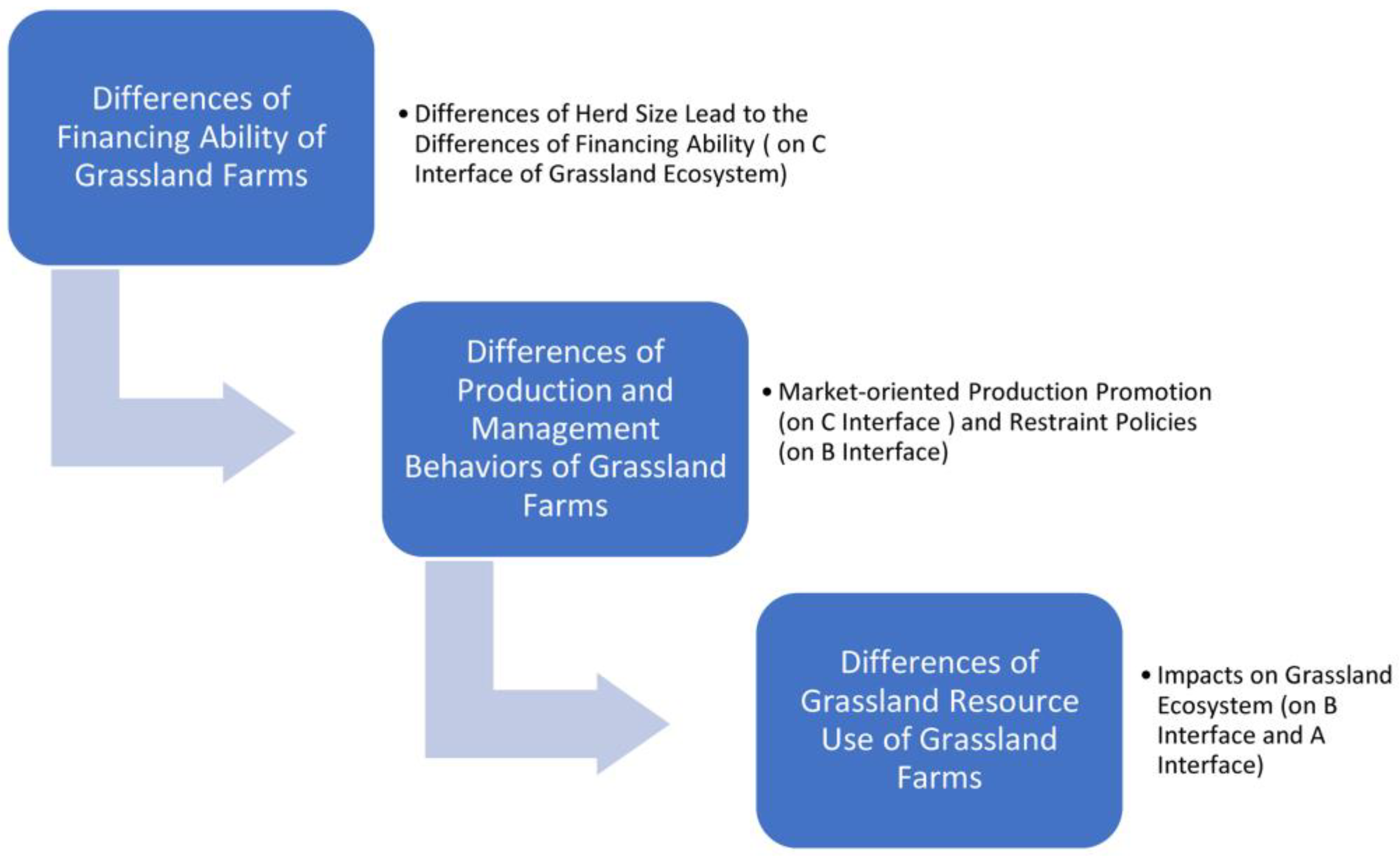Improved Management of Grassland to Promote Sustainable Use Based on Farm Size
Abstract
1. Introduction
2. Materials and Methods
2.1. Research Area
2.2. Data Sources and Indicator Specifications
2.3. Sample Farm Production Function
2.4. Analysis Methodology
3. Results
3.1. Different Behaviors of Farms in Financing, Grassland Circulation, and Overgrazing Management
3.1.1. Expanding Production Scale by Financing
3.1.2. Different Grassland Circulation Behaviors
3.1.3. Overgrazing Management in Farms
3.2. Differential Use of Production Factors
4. Discussion
4.1. Differential Mechanisms of Grassland Resource Use
4.2. Overgrazing Management of farms
4.3. Grassland Circulation Bottleneck and Herders Leaving the Grasslands
4.4. Potential Risk Related to Farm Size
4.5. Preparation for the Development of Larger Farms
5. Conclusions
Author Contributions
Funding
Institutional Review Board Statement
Data Availability Statement
Acknowledgments
Conflicts of Interest
References
- Li, B. The grassland resources of China and its management strategy. Explor. Nat. 1997, 16, 12–14. [Google Scholar]
- Gang, C.; Zhou, W.; Chen, Y.; Wang, Z.; Sun, Z.; Li, J.; Qi, J.; Odeh, I. Quantitative assessment of the contributions of climate change and human activities on global grassland degradation. Environ. Earth Sci. 2014, 72, 4273–4282. [Google Scholar] [CrossRef]
- Ren, J.; Hou, F. Principles of grassland resources management. Acta Agrestia Sin. 2004, 12, 261–263. [Google Scholar] [CrossRef]
- Weber, K.T.; Horst, S. Desertification and livestock grazing: The roles of sedentarization, mobility and rest. Pastoralism 2011, 1, 19. [Google Scholar] [CrossRef]
- Moinardeau, C.; Mesléard, F.; Ramone, H.; Dutoit, T. Short-term effects on diversity and biomass on grasslands from artificial dykes under grazing and mowing treatments. Environ. Conserv. 2019, 46, 132–139. [Google Scholar] [CrossRef]
- Li, Y.; Gai, Z.; Ma, J. Study of policy changes in Inner Mongolia pastoral area and agriculture and animal husbandry development. Res. Agric. Mod. 2010, 31, 15–18. [Google Scholar]
- Li, Z.; Han, G.; Zhao, M.; Wang, Z.; Wang, J. An overview of the prospects for family farms. Acta Prataculturae Sin. 2015, 24, 158–167. [Google Scholar] [CrossRef]
- Zhou, D.; Jiang, S.; Wang, P. The problems and strategies for grassland management in Northern China. Grassl. China 2004, 26, 57–64. [Google Scholar] [CrossRef]
- Ren, J. The definition, analysis and relevant description of several professional vocabulary. Acta Prataculturae Sin. 2015, 24, 1–4. [Google Scholar] [CrossRef]
- Ren, J.; Nan, Z.; Hao, D. The three major interfaces within pratacultural system. Acta Prataculturae Sin. 2000, 9, 1–8. [Google Scholar] [CrossRef]
- Fang, K.; Song, N.; Wei, L.; An, H. The effect of different grazing systems on aboveground biomass and interspecific relationships in desert steppe. Acta Prataculturae Sin. 2012, 21, 12–22. [Google Scholar]
- Hamilton, C. The genuine progress indicator methodological developments and results from Australia. Ecol. Econ. 1999, 30, 13–28. [Google Scholar] [CrossRef]
- Ding, Y.; Niu, J.; Chen, L.; Dong, J.; Jia, J.; Li, X.; Hu, E.; Guo, J. Evaluation of sustainable development of compound ecosystem on the scale of household pasture. Bull. Soil Water Conserv. 2008, 28, 156–161. [Google Scholar] [CrossRef]
- Wang, Y.; Xiu, C.; Cao, J. The role of climate factors and overgrazing in grassland degradation and evolution in Inner Mongolia. J. Agrotech. Econ. 2015, 8, 112–117. [Google Scholar] [CrossRef]
- Li, X. The “Back-to-Pasture” projects to retire cropland in Inner Mongolia and their impacts on the herdsmen’s income. J. Agrotech. Econ. 2006, 3, 63–68. [Google Scholar] [CrossRef]
- Research Group of Inner Mongolia Development Research Center. Investigation and consideration on the income of herders in Inner Mongolia. North. Econ. 2009, 21, 8–11. [Google Scholar]
- Ao, R. The changing and bring forth new ideas of the property in grassland. Inner Mong. Soc. Sci. 2003, 24, 116–120. [Google Scholar] [CrossRef]
- Bao, Y. The degeneration and desertification of the Inner Mongolia grasslands caused by the regulatory system and policy. J. Inner Mong. Norm. Univ. Philos. Soc. Sci. 2003, 28, 28–32. [Google Scholar] [CrossRef]
- Zhang, Q.; Li, W. Distributed overgrazing: A neglected cause of grassland degradation in Inner Mongolia. J. Arid Land Resour. Environ. 2008, 22, 8–16. [Google Scholar]
- He, X.; Niu, J.; Guo, X.; Zhang, Q. The behavior differentiation mechanisms of grassland resource utilization and management strategies of households in a typical steppe region. Acta Prataculturae Sin. 2013, 22, 257–265. [Google Scholar] [CrossRef]
- Thornton, P.K. Livestock production: Recent trends, future prospects. Philos. Trans. R. Soc. Lond. B Biol. Sci. 2010, 365, 2853–2867. [Google Scholar] [CrossRef] [PubMed]
- Xu, R.; Ren, J.; Nan, Z.; Huang, J.; Deng, X.; Lin, H.; Qiu, H.; Research Group of Strategies to Ensure Grassland Ecological and Food Security in China. Strategies and policies for the ecological and food security of China’s grassland. Strateg. Study Chin. Acad. Eng. 2016, 18, 8–16. [Google Scholar] [CrossRef]
- Qi, J.; Xin, X.; John, R.; Groisman, P.; Chen, J. Understanding livestock production and sustainability of grassland ecosystems in the Asian Dryland Belt. Ecol. Process. 2017, 6, 22. [Google Scholar] [CrossRef]
- Tóth, E.; Deák, B.; Valkó, O.; Kelemen, A.; Miglécz, T.; Tóthmérész, B.; Török, P. Livestock type is more crucial than grazing intensity: Traditional cattle and sheep grazing in short-grass steppes. Land Degrad. Dev. 2018, 29, 231–239. [Google Scholar] [CrossRef]
- Zhang, R.; Tan, S.; Hannaway, D.; Dai, W. Multi-household grassland management pattern promotes ecological efficiency of livestock production. Ecol. Econ. 2020, 171, 106618. [Google Scholar] [CrossRef]
- Wang, J.; Ju, F. Factors influencing the land transaction behavior for farmers in rural areas and pastureland of Inner Mongolia. J. Arid Land Resour. Environ. 2015, 29, 74–79. [Google Scholar] [CrossRef]
- Yang, B.; Wu, J.; Yang, L.; Kemp, D.; Gong, X.; Takahashi, T.; Feng, M. Metabolic energy balance and countermeasures study in the north grassland of China. Acta Prataculturae Sin. 2012, 21, 187–195. [Google Scholar]
- Bryan, B.A.; Gao, L.; Ye, Y.; Sun, X.; Connor, J.D.; Crossman, N.D.; Stafford-Smith, M.; Wu, J.; He, C.; Yu, D.; et al. China’s response to a national land-system sustainability emergency. Nature 2018, 559, 193–204. [Google Scholar] [CrossRef]



| Manners in Which Farms Financed Production | Year | Small Farm Group | Large Farm Group |
|---|---|---|---|
| Annual average amount of borrowed funds (thousand CNY) | 2006 | 9.32 | 34.30 |
| 2009 | 22.60 | 64.60 | |
| 2015 | 31.20 | 62.90 | |
| Main loan channels | Loans from relatives | Private credit loans | |
| Main use of loan funds | Purchase forage, pay for grassland rent and living needs | Rent more grasslands, pay for grassland rent, and purchase forage | |
| Farm Leasing | Year | Small Farm Group | Large Farm Group |
|---|---|---|---|
| Number of farms with leasing behavior | 2009 | 60 | 44 |
| 2015 | 49 | 45 | |
| Average rental area (hm2) | 2009 | 153.9 | 345.3 |
| 2015 | 170.4 | 411.5 | |
| Price of leased grasslands (CNY/hm2) | 2009 | 105–150 | 105–150 |
| 2015 | 230–280 | 230–280 | |
| Main use of leased grasslands | Grazing | Grazing, mowing, and reserve for the balance policy | |
| Main forms of lease transaction | Cooperative operation | Cash payment | |
| Estimation Output for: | Total Pool (Balanced) Observations | Coefficient βA (lnA) | Coefficient βK (lnK) | Coefficient βL (lnL) | |
|---|---|---|---|---|---|
| All farms | 1638 | 0.7321 | 0.3819 | 0.5762 | 1.6902 |
| Small farm group | 1053 | 0.8329 | 0.3290 | 0.4192 | 1.5811 |
| Large farm group | 585 | 0.6403 | 0.4268 | 0.6846 | 1.7517 |
Disclaimer/Publisher’s Note: The statements, opinions and data contained in all publications are solely those of the individual author(s) and contributor(s) and not of MDPI and/or the editor(s). MDPI and/or the editor(s) disclaim responsibility for any injury to people or property resulting from any ideas, methods, instructions or products referred to in the content. |
© 2023 by the authors. Licensee MDPI, Basel, Switzerland. This article is an open access article distributed under the terms and conditions of the Creative Commons Attribution (CC BY) license (https://creativecommons.org/licenses/by/4.0/).
Share and Cite
He, X.; Wei, J.; Gu, S.; Wang, L.; Tian, Z.; Chen, D.; Yuan, J. Improved Management of Grassland to Promote Sustainable Use Based on Farm Size. Agriculture 2023, 13, 350. https://doi.org/10.3390/agriculture13020350
He X, Wei J, Gu S, Wang L, Tian Z, Chen D, Yuan J. Improved Management of Grassland to Promote Sustainable Use Based on Farm Size. Agriculture. 2023; 13(2):350. https://doi.org/10.3390/agriculture13020350
Chicago/Turabian StyleHe, Xin, Jingru Wei, Suhua Gu, Luping Wang, Zechen Tian, Danqiong Chen, and Jiazhi Yuan. 2023. "Improved Management of Grassland to Promote Sustainable Use Based on Farm Size" Agriculture 13, no. 2: 350. https://doi.org/10.3390/agriculture13020350
APA StyleHe, X., Wei, J., Gu, S., Wang, L., Tian, Z., Chen, D., & Yuan, J. (2023). Improved Management of Grassland to Promote Sustainable Use Based on Farm Size. Agriculture, 13(2), 350. https://doi.org/10.3390/agriculture13020350





